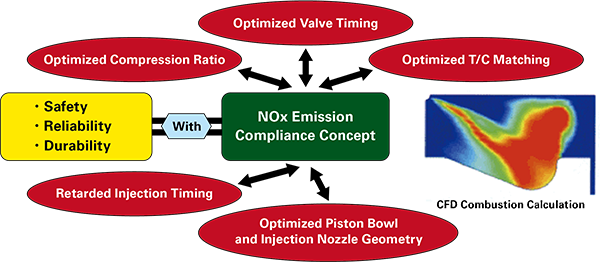Nitrogen Oxides (NOx) Regulations
The International Maritime Organization (IMO) NOx Tier III standards that became effective in 2016 required an 80% reduction in NOx emissions compared to Tier I. To meet these stringent standards, Daihatsu Diesel has adopted the SCR (Selective Catalytic Reduction), a compact, reliable and durable exhaust gas after-treatment system. This SCR System is marketed as a set with all Daihatsu Diesel’s engines (300 to 8000 kW).
All of our engines shipped after 2000 satisfy the IMO NOx regulations, as testified by the main classification societies following an appraisal of our engines’ NOx emissions.
Please find an outline of the NOx regulations below.
NOx regulations and start timings


<Tier1>
MARPOL Annex VI [International Convention for the Prevention of Pollution from Ships], effective from May 2005, was the first set of regulations concerning NOx emissions. It was applied retroactively to engines installed on oceangoing ships from January 1, 2000 onwards, and affected coastal ships constructed after May 19, 2005.
<Tier2>
Tier II, included in the revised MARPOL Annex VI adopted in October 2008, required a 15% to 22% reduction in NOx emissions over the first regulations. This amendment entered into force on July 1, 2010 and was applied to engines installed on vessels whose keel-laying date was on or after January 1, 2011.
It was important to Daihatsu Diesel that our Tier II compliant engines not only met these regulations but did so without compromising the safety, reliability and durability that is core to our products. Therefore all of our Tier II compliant engines have optimized compression ratios, valve timings, high pressure superchargers, fuel injection timings, combustion chambers and fuel injection valves.
Furthermore, aside from maintaining general performance and fuel economy, we fine-tune our engines to ensure that if using lower-grade fuel oil there is no performance reduction during low load combustion or to the instantaneous speed variation rate.
NOx Emission Compliance Concept

<Tier3>
Tier III regulations apply when any ship’s keel-laying date is after January 1, 2016 navigates an ECA (Emission Control Area) within 200 nautical miles of North America, Canada and the Caribbean Sea. In addition, after January 1, 2021 this regulation will extend to include the ECAs in the North Sea and the Baltic Sea.
Tier III regulations require a further 80% NOx reduction compared to Tier I, a difficult task for the engine alone and so after-treatment equipment is necessary. For this reason, we have partnered with leaders in marine Selective Catalytic Reduction (SCR) technology company, D.E.C. Marine AB (head office: Sweden), who have shipped about 400 SCR units to date.
The resulting engine-SCR arrangement (Scheme A) has proven, full Tier III compliance. NOx testing took place in the field and in our factory witnessed by the main classification societies, and we have already received Tier III compliance certificates for all our major engine models.
In addition, we also offer a device that produces on-board the aqueous urea solution that is required as a reducing agent for the SCR (Selective Catalytic Reduction) system has been developed. Since it generates only the necessary amount of aqueous urea solution at the necessary time from pure water and urea powder, there are no concerns about degradation, and a solution of consistently stable quality can be supplied. Also, because there is no need for large tanks to store the solution in liquid form, it offers space-saving storage, and the procurement of urea powder is economical.
It is important to note that components within our engines that are affected by NOx level controls are stamped with ID numbers indicating they conform to the regulations. These numbers are checked by surveyors and so to maintain compliance please only use Daihatsu Diesel genuine parts, as listed in the technical files, when replacing parts. Please note compliance certificates cannot be renewed if it is confirmed that parts with different ID numbers are fitted.
SOx Regulation
This regulation controls the sulfur concentration in the fuel used in the engine as a method for regulating the SOx content in the exhaust gas. Currently, it is mandatory to use fuel with a sulfur content of 3.5% or less outside ECAs and 0.1% or less in ECAs.
However, unlike the NOx regulations, the current SOx regulated ECAs already include the North Sea and the Baltic Sea areas, as well as the areas within 200 nautical miles of North America, Canada and the Caribbean Sea. Furthermore, at the 70th Marine Environment Protection Committee (MEPC 70) held in October 2016, it was agreed to further limit the sulfur concentration of fuel oil used outside ECAs to less than 0.5% from 2020.
1. Use fuel with a sulfur content of 0.5% or less.
IMO TIMELINE.
FOR REDUCTION IN FUEL SULFUR CONTENT

When considering your own response to the above regulation in your ship building, please contact us and we will happily explain the various technologies and support available to you.


